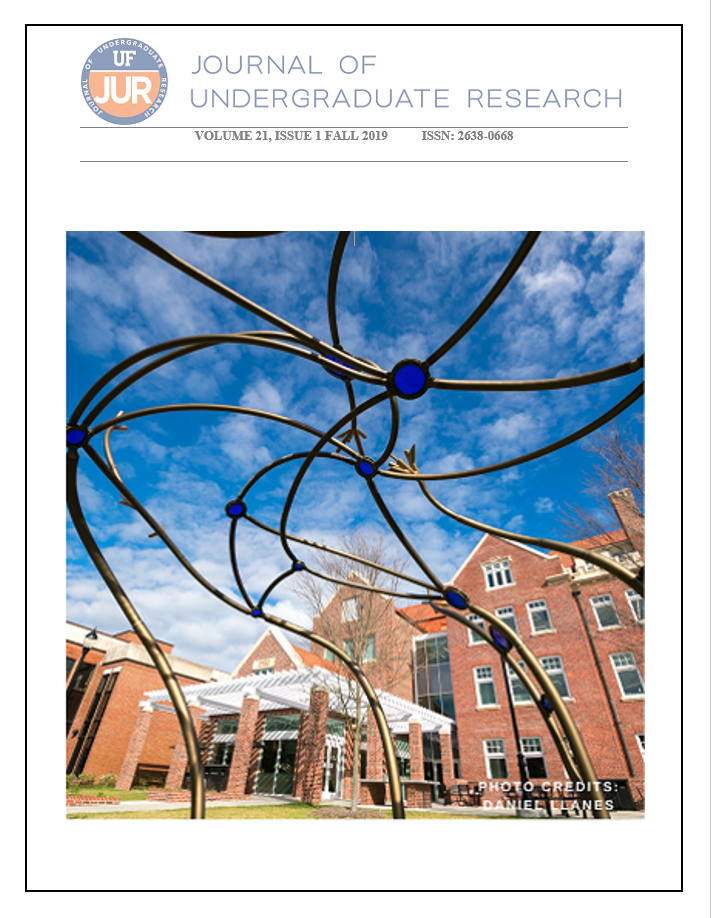Morphology of an autotomy fracture plane explains some of the variation in the latency to autotomize
DOI:
https://doi.org/10.32473/ufjur.v21i1.107979Keywords:
Anti-predation, Autotomy, Coreidae, HemipteraAbstract
A gecko dropping its tail to escape predation beautifully illustrates the anti-predatory benefits associated with autotomy, i.e., the self-induced loss of a limb. The amount of time it takes an organism to drop its autotomizable limb can dramatically vary from one individual to the next, and the factors that are responsible for this variation remain unclear. Here, we investigated whether the size of the auototomy fracture plane, a morphological character, could explain variation in the latency to autotomize. We found that individuals with larger fracture planes took longer to autotomize when we statistically controlled for an individual’s body size and sex. These results support previous assumptions about the relationship between fracture plane size and latency to autotomize. Namely, large individuals, with relatively small autotomy fracture planes, can drop their autotomizable limbs quickly, which likely improves their success in using this anti-predatory tactic.
Metrics
References
Arnold EN. (1984). Evolutionary aspects of tail shedding in lizards and their relatives. J Nat Hist. 18, 127–169.
Bateman, P.W., Fleming, P.A. (2008) An intra- and interspecific study of body size and autotomy as a defense in Orthoptera. J Orthop. Res. 17, 315-320.
Bose, A. P. H. and Robinson, B. W. (2013). Invertebrate predation predicts variation in an autotomy-related trait in larval damselfly. Evol. Ecol. 27, 27-38.
Daniels, C. (1984). The Importance of Caudal Lipid in the Gecko Phyllodactylus marmoratus. Herpetologica. 40, 337-344.
Emberts, Z., St Mary, CM., Miller, CW. (2016). Coreidae (Insecta: Hemiptera) limb loss and autotomy. Ann Entomol Soc Am. 109, 678–683.
Emberts, Z., St Mary, CM., Miller, CW., Kiehl, D. (2017) Cut your Losses: self-amputation of inured limbs increases survival. Behavioral Ecology. 28, 1047-1054.
Emberts, Z., St. Mary, CM., Herrington, TJ., & Miller, CW. (2018). Males missing their sexually selected weapon have decreased fighting ability and mating success in a competitive environment. Behavioral Ecology and Sociobiology. 72, 81.
Fleming, P. A., Muller, D., & Bateman, P. W. (2007). Leave it all behind: a taxonomic perspective of autotomy in invertebrates. Biological Reviews. 82, 481-510.
Fox, S. F., Conder, J. M. and Smith, A. E. (1998). Sexual dimorphism in the ease of tail autotomy: Uta stansburiana with and without previous tail loss. Copeia. 1998, 376-382.
Gleason, J., Fudge, D., Robinson, B. (2014). Eco-mechanics of lamellar autotomy in larval damselflies. J Exp Biol. 217, 185-191.
Luscher M. (1948). The regeneration of legs in Rhodnius prolixus (Hempiptera). J Exp Biol. 25, 334–343.
Maginnis TL. (2006). The costs of autotomy and regeneration in animals: a review and framework for future research. Behav. Ecol. 17, 857–872.
Maginnis TL. (2008). Autotomy in a Stick Insect. Florida Entomologist. 91, 126-127.
Marrs, SJ. Wilkie, IC. Skold, M. et al. (2000). Size-related aspects of arm damage, tissue mechanics, and autotomy in the starfish Asterias rubens. Mar Biol. 137, 59–70.
Miller, C.W. & De Lestang, F.N. (2009). Effects of Diet on Development and Surviviorship of Narnia femorata Nymphs. Florida Entomological Society. 92, 511-512.
Nolen, Z., Allen, P., Miller, CW. (2017). Seasonal resource value and male size influence male aggressive interactions in the leaf footed cactus bug, Narnia femorata. Behav Processes. 138, 1–6.
Procter, DS., Moore, AJ., Miller, CW. (2012). The form of sexual selection arising from male-male competition depends on the presence of females in the social environment. J Evol Biol. 25, 803–812.
Wasson, K., & Lyon, BE. (2005). Flight or fight: flexible antipredatory strategies in porcelain crabs. Behav Ecol. 16, 1037–1041.
Webb, JK. (2006). Effects of tail autotomy on survival, growth and territory occupation in free-ranging juvenile geckos (Oedura lesueurii). Austral Ecol. 31, 432–440
Downloads
Published
Issue
Section
License
Some journals stipulate that submitted articles cannot be under consideration for publication or published in another journal. The student-author and mentor have the option of determining which journal the paper will be submitted to first. UF JUR accepts papers that have been published in other journals or might be published in the future. It is the responsibility of the student-author and mentor to determine whether another journal will accept a paper that has been published in UF JUR.

